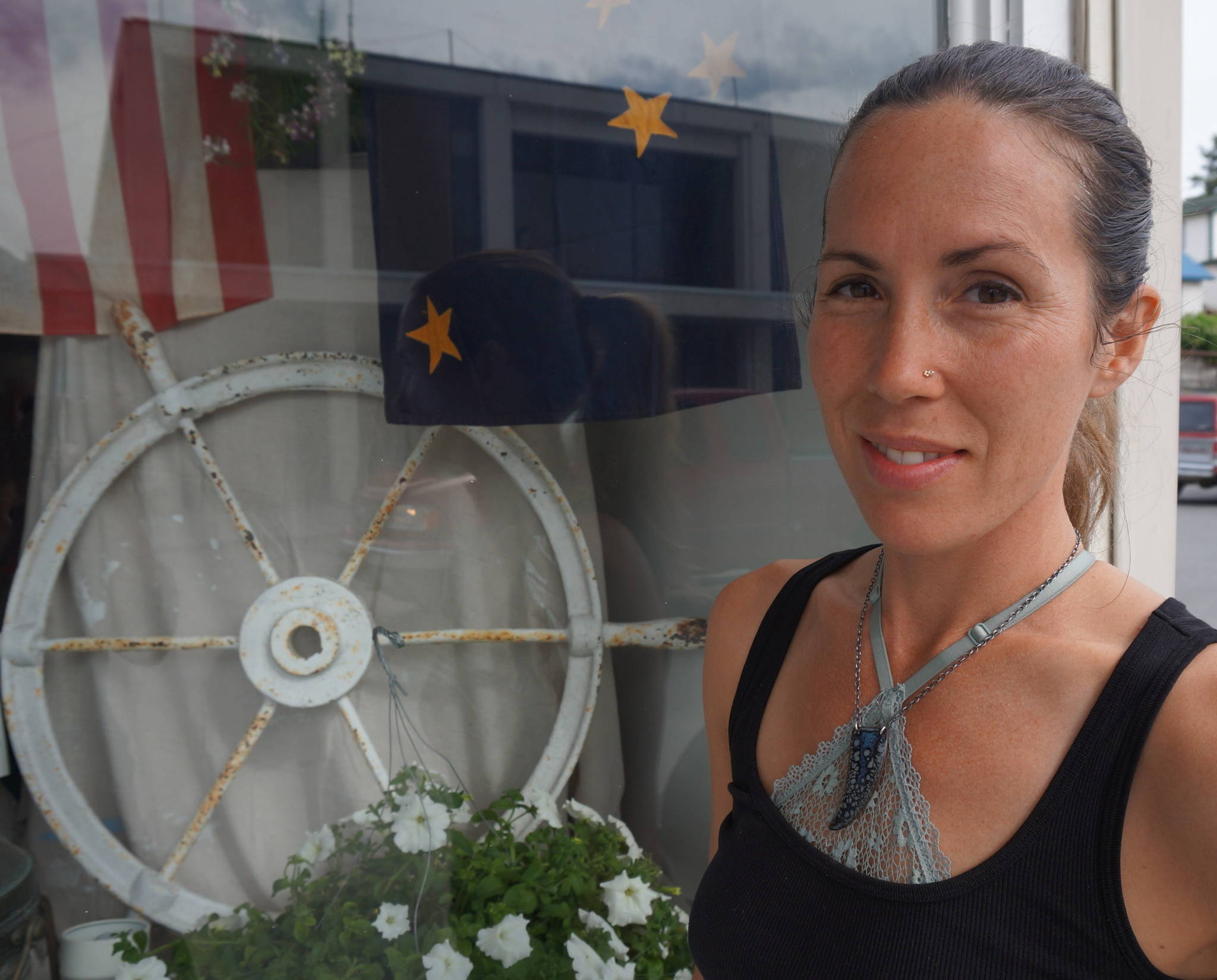It happens fast. When the fishermen go to the grounds and leave empty harbor stalls, I find myself imagining Petersburg in the wintertime. I know! It’s too early! But part of a successful winter is laying groundwork in summer. Artist Janine Gibbons, originally from Petersburg, is renting a space in downtown Petersburg with exactly that in mind.
She’s calling it The Fleet. The details are still coming together, but she’s hoping to turn it into a collaborative art space to bring together community talent and resources for creative pursuits. Everyone’s invited. The shop stands at the corner of Main Street and Fram. It has two display windows, currently bedecked with a collection of flags interspersed with planters of flowers. The space stretches deep into the building where an office awaits.
We sat on two high-backed maroon armchairs in the front of the room, watching downtown traffic on a sunny day. Folks wearing name tags wandered to town from the small cruise ship. Fishermen prepared to head out. The door was open to let in sunshine and ease the oil paint smell that still lingered. Gibbons and a few helpers had just ripped out the old carpeting, then painted the walls and floor to prepare for the fresh start. The school’s surplus sale that week yielded chairs, tables and other supplies perfect for the burgeoning creative classroom. Surrounded by possibility, Gibbons told me how she got to this point.
The Fleet is part of a long path for the Petersburg-raised artist. Gibbons had always been creative, but was on track to become an elementary teacher. She began having seizures regularly, impacting her ability to fulfill the student teaching requirement. It was the only thing standing between her and the degree. But she paused school and started making art. The seizures stopped. After years of determination and assembling a hardworking team, as well as continuing her education, her glass enameled jewelry can be found in stores across Southeast Alaska and around the country. Eventually, something wasn’t right. Working on her paintings became a new source of inspiration, yet her new path still seemed opaque. Gibbons asked for a sign.
Then she got an email from Sealaska Heritage Institute, inquiring about her availability to do the artwork for two children’s books. She didn’t really have the time, not with a successful jewelry business to run, but she made it happen anyway.
“I haven’t slept since October,” she laughed, and I believe her. Her books, “The Woman Who Married a Bear” and “The Woman Carried Away by Killer Whales,” are illustrated adaptations of traditional stories. They’re part of Baby Raven Reads, an SHI program supporting language development, school readiness and pre-literacy for Alaska Native families. The extensive research and traveling she did to finish the books had her learning more about her Haida heritage.
“Each page of the book was me learning about my family,” Gibbons explained. The power of the stories came alive for her through trips like visiting the Haida artwork located in the Museum of Anthropology at University of British Columbia. “Before things just felt like words, but now they feel real.”
Part of that reality was reckoning with the generational trauma caused by colonization. “People endured so much they just stopped talking, they stopped telling stories. I mean, one ancestor went to her deathbed not wanting people to know she was Haida. What does a person have to experience for that to happen to them?” Gibbons asked. “But now people seem ready, you know? Like, there’s been enough pain. It’s time to tell stories again.”
She leaned forward in her chair, thinking about her ancestors. “Did they know that some of us would still be here to tell this story?”
Gibbons sees The Fleet as a place for anyone who has something to offer or is interested in learning.
“The space is about coming together. I don’t know everything, yet, but I would like to, and I think that together we can find a lot of answers.” Gibbons knows the value of mentorship; she credits Ketchikan artists Ray and Michelle Troll and Donald Varnell with giving her essential guidance as her art has developed over the years. Part of mentorship is knowing each person has the freedom to grow. Gibbons reminisced on the beginning of her time as an artist in Ketchikan, saying, “Oh my God you get to be unapologetically yourselves? I would really just like to help other people get that feeling too. To have someone who understands the creative process is pretty priceless.”
There’s quite a bit of work to do before The Fleet operates at full gear. But Gibbons has experience making things work when failure isn’t an option. “We can make this space whatever you want it to be. Even when it’s raining, if you have a good space to be in, who cares? Why not make Petersburg the place you always want to be? A space where everyone’s invited, no one’s excluded.” She also dreams of a gathering place to think about larger issues facing us. “We feel challenges globally, especially with things like ocean threats, so why can’t we be here, on the ocean, to think creatively about what’s happening? I mean, really. How can we save the world?”
To learn more about The Fleet, contact Janine at janineklgibbons@gmail.com.

